Showing Spotlights 305 - 312 of 2838 in category All (newest first):
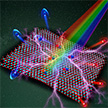 Near-infrared photodetectors play a significant role in many aspects of research and daily life and twisted-angle-induced unusual electrical and optical properties in van der Waals homostructures have received extraordinary attention recently. However, these emerging properties have rarely been applied to optoelectronic devices. Here, researchers demonstrate broadband photoresponse capable of overcoming the band-gap limitation of semiconductors in the twisted lead iodide homostructures.
Near-infrared photodetectors play a significant role in many aspects of research and daily life and twisted-angle-induced unusual electrical and optical properties in van der Waals homostructures have received extraordinary attention recently. However, these emerging properties have rarely been applied to optoelectronic devices. Here, researchers demonstrate broadband photoresponse capable of overcoming the band-gap limitation of semiconductors in the twisted lead iodide homostructures.
Oct 26th, 2022
 Artificially engineered chiral materials with exceptional light-manipulating capabilities show significantly enhanced chiroptical response and capability of light manipulation, which have emerged as a promising chiral platform for applications in biosensing, catalysis, and photonics. Scientists now report a novel class of chiral materials called bichiral nanoparticles that can easily tune the sign of circular dichroism through the hybridization of bichiral centers without inverting the geometric chirality.
Artificially engineered chiral materials with exceptional light-manipulating capabilities show significantly enhanced chiroptical response and capability of light manipulation, which have emerged as a promising chiral platform for applications in biosensing, catalysis, and photonics. Scientists now report a novel class of chiral materials called bichiral nanoparticles that can easily tune the sign of circular dichroism through the hybridization of bichiral centers without inverting the geometric chirality.
Oct 18th, 2022
 In an effort to reduce the size of optical spectrometers, researchers have been working on developing miniature on-chip spectrometers that could be integrated into small handheld devices or even smartphones. Now, reducing the size down to the micrometer scale, researchers have developed a single-dot spectrometer based on an in situ modulated perovskite photodetector. The device is enabled by photogain manipulation controlled by ion redistribution in the perovskite film under an externally applied bias. This unique spectrometer design breaks the footprint-resolution restriction of spectrum analysis and leads to a new design direction of perovskite in situ modulation for the development of new functional devices.
In an effort to reduce the size of optical spectrometers, researchers have been working on developing miniature on-chip spectrometers that could be integrated into small handheld devices or even smartphones. Now, reducing the size down to the micrometer scale, researchers have developed a single-dot spectrometer based on an in situ modulated perovskite photodetector. The device is enabled by photogain manipulation controlled by ion redistribution in the perovskite film under an externally applied bias. This unique spectrometer design breaks the footprint-resolution restriction of spectrum analysis and leads to a new design direction of perovskite in situ modulation for the development of new functional devices.
Oct 13th, 2022
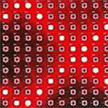 Researchers demonstrate a multitarget real-time trajectory tracking system by using a time-division position sensitive detector (TD-PSD) system by employing a graphene-silicon Schottky heterojunction. The system allows for multi-target real-time trajectory tracking with a maximum image output frame rate of up to 62 000 frames per second (which is superior to commercial optical high-speed motion capture systems of about 1000 frames per second). This breaks the bottleneck in precise high-speed trajectory tracking and multi-target detection of traditional position sensitive detectors.
Researchers demonstrate a multitarget real-time trajectory tracking system by using a time-division position sensitive detector (TD-PSD) system by employing a graphene-silicon Schottky heterojunction. The system allows for multi-target real-time trajectory tracking with a maximum image output frame rate of up to 62 000 frames per second (which is superior to commercial optical high-speed motion capture systems of about 1000 frames per second). This breaks the bottleneck in precise high-speed trajectory tracking and multi-target detection of traditional position sensitive detectors.
Oct 10th, 2022
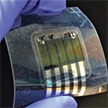 Researchers have been able to successfully replace the expensive metal layer of the top electrode of perovskite solar cells with a less-expensive carbon-based electrode that can also be applied using roll-to-roll techniques. This new electrode deposition method involves the deposition of carbon and silver on a detachable plastic (PET) substrate first, with the dried electrode then pressed onto the top of the perovskite solar cell. The PET layer is then removed and can be reused.
Researchers have been able to successfully replace the expensive metal layer of the top electrode of perovskite solar cells with a less-expensive carbon-based electrode that can also be applied using roll-to-roll techniques. This new electrode deposition method involves the deposition of carbon and silver on a detachable plastic (PET) substrate first, with the dried electrode then pressed onto the top of the perovskite solar cell. The PET layer is then removed and can be reused.
Sep 29th, 2022
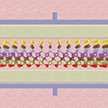 Researchers show how MXenes' rich chemistry can be used to create doping-free 2D transistors with intrinsically low resistive contacts while maintaining balance mode operation. With a suitable functional termination, MXenes can become a semiconductor or a metal with a different work function. The researchers exploit this unique property of MXene to propose a Schottky barrier transistor, which can be implemented with a bare MXene by converting it to a semiconductor in the channel region with strategic functionalization.
Researchers show how MXenes' rich chemistry can be used to create doping-free 2D transistors with intrinsically low resistive contacts while maintaining balance mode operation. With a suitable functional termination, MXenes can become a semiconductor or a metal with a different work function. The researchers exploit this unique property of MXene to propose a Schottky barrier transistor, which can be implemented with a bare MXene by converting it to a semiconductor in the channel region with strategic functionalization.
Sep 27th, 2022
 New research describes the first example of self-powered bioelectronics on a mask that can measure the biological glucose signal with continuous energy. In their work, the researchers demonstrate a 3-in-1 mask device that can 1) harvest energy (a biofuel cell); 2) store energy (a supercapacitor); and 3) indicate glucose concentration (a biosensor). The small biofuel cells can harvest energy from the sweat on a person's face and indicate the level of the analyte that tracks health and nutrition.
New research describes the first example of self-powered bioelectronics on a mask that can measure the biological glucose signal with continuous energy. In their work, the researchers demonstrate a 3-in-1 mask device that can 1) harvest energy (a biofuel cell); 2) store energy (a supercapacitor); and 3) indicate glucose concentration (a biosensor). The small biofuel cells can harvest energy from the sweat on a person's face and indicate the level of the analyte that tracks health and nutrition.
Sep 19th, 2022
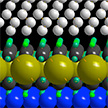 Two-dimensional (2D) semiconductors, like transition-metal dichalcogenides, have become a competitive alternative to traditional semiconducting materials in the post-Moore era, and caused worldwide interest. However, before they can be used in practical applications, some key obstacles must be resolved. One of them is the large electrical contact resistances at the metal-semiconductor interfaces. Researchers have proposed a brand-new contact resistance lowering strategy of 2D semiconductors with a good feasibility, a wide generality and a high stability.
Two-dimensional (2D) semiconductors, like transition-metal dichalcogenides, have become a competitive alternative to traditional semiconducting materials in the post-Moore era, and caused worldwide interest. However, before they can be used in practical applications, some key obstacles must be resolved. One of them is the large electrical contact resistances at the metal-semiconductor interfaces. Researchers have proposed a brand-new contact resistance lowering strategy of 2D semiconductors with a good feasibility, a wide generality and a high stability.
Sep 5th, 2022
 Near-infrared photodetectors play a significant role in many aspects of research and daily life and twisted-angle-induced unusual electrical and optical properties in van der Waals homostructures have received extraordinary attention recently. However, these emerging properties have rarely been applied to optoelectronic devices. Here, researchers demonstrate broadband photoresponse capable of overcoming the band-gap limitation of semiconductors in the twisted lead iodide homostructures.
Near-infrared photodetectors play a significant role in many aspects of research and daily life and twisted-angle-induced unusual electrical and optical properties in van der Waals homostructures have received extraordinary attention recently. However, these emerging properties have rarely been applied to optoelectronic devices. Here, researchers demonstrate broadband photoresponse capable of overcoming the band-gap limitation of semiconductors in the twisted lead iodide homostructures.
 Subscribe to our Nanotechnology Spotlight feed
Subscribe to our Nanotechnology Spotlight feed





